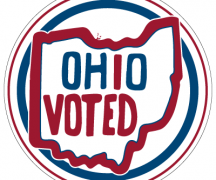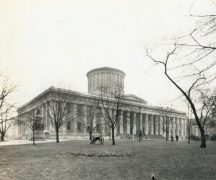By Nick Manes & Susan Tebben
In 2016, Donald Trump ran on “bringing back” manufacturing jobs to Rust Belt states like Pennsylvania, which was one factor in his surprise wins in Michigan, Wisconsin and Michigan (and less surprising victory in neighboring Ohio).

“The heart of the [economic] slowdown has really been in manufacturing. The global manufacturing sector is in a recession right now, but the U.S. is doing a little better than everyone else,” Aditya Bhave, vice president and global economist for Bank of America Merrill Lynch Global Research, said during a Business Leaders for Michigan event in Detroit in November.
While manufacturing in Ohio has edged up slightly over the past 10 years, the Buckeye State is currently forecasted to lose 40,000 manufacturing industry jobs by 2026.
Much of the uncertainty comes from the trade and tariff policies from the Trump administration — a policy pitch that helped him win voters throughout old blue-collar Democratic strongholds in the Rust Belt.
Last month, Trump signed the United States-Mexico-Canada Agreement (USMCA), which received overwhelming bipartisan support in Congress. He referenced the deal at a rally in Hershey, PA in December.
In his State of the Union address earlier this month, Trump touted the USMCA, saying that it would help with “bringing back our manufacturing jobs, expanding American agriculture, protecting intellectual property, and ensuring that more cars are proudly stamped with four beautiful words: made in the USA.”
Despite widespread legislative support, manufacturing experts note that the USMCA is largely a replacement of the dated North American Free Trade Agreement (NAFTA).
With Canada and Mexico accounting for 33 percent of US exports, according to federal data, “that treaty just ratified should begin to help normalizing” the flow of goods and buoy manufacturers, said David Taylor, president of the Pennsylvania Manufacturer’s Association, an industry lobbying group and trade association.
Also, trade tensions between the United States and China appear to be cooling, as both Trump and Chinese President Xi Jinping recently reaffirmed their support for the first phase of a new trade agreement, Reuters reported.
Economic impact
Pennsylvania’s manufacturing industry has seen ups and downs, but it’s role in the state’s economy is still large.
According to the the National Association of Manufacturers, an industry trade group, manufacturing output was worth $93.75 billion. That’s almost 12 percent of the commonwealth’s GDP.
The Bureau of Labor Statistics lists 575,000 manufacturing jobs in Pennsylvania. Those workers bring home a weekly paycheck of $1,199, or roughly $62,348 over the course of a year.
Overall, this makes Pennsylvania the sixth biggest state for manufacturing jobs, with only fellow rust beltians Ohio and Michigan ahead.
But Taylor said those employment numbers could be even higher.
“There are 6,000 open manufacturing positions where our employers are having great difficulty in finding qualifying employees,” Taylor said.
At times over Trump’s first term, Pennsylvania’s most symbolic industry, steel, looked to be on the upswing.
Last year, U.S. Steel promised to invest $1 billion into three steelmaking facilities south of Pittsburgh — including the 145-year old Edgar Thomson Steel Works in Braddock, Pa., outside Pittbsburgh.
The investment would make the plant more efficient as well as reduce pollution, the company said.
“This is a truly transformational investment for U. S. Steel. We are combining our integrated steelmaking process with industry-leading endless casting and rolling to reinvest in steelmaking and secure the future for a new generation of steelworkers in Western Pennsylvania and the Mon Valley,” David Burritt, the company’s president and CEO, said in a May 2019 press release.
The decision came as the industry was riding high on tariff-juiced steel prices. Since, prices have fallen, shrinking revenues.
U.S. Steel finished 2019 in the red, and also announced that it was slowing down its previously announced investment in Pennsylvania.
Instead, it was purchasing an under-construction mill in Arkansas that turns scrap metal into usable steel.
“We’re actually pivoting to the future and focusing on the company we want to become,” Burritt said at the time, according to Pittsburgh Post-Gazette.
At the start of 2019, Ohio manufacturers held 706,800 jobs, according to preliminary numbers from the Bureau of Labor Statistics. By the end of the year, preliminary numbers say the state had 701,500 jobs in the industry.
Jamie Karl, of the Ohio Manufacturing Association, said there has been growth overall, and the industry within the state has increased since Trump took office.
“Over the last year, we have fluctuated, and I would attribute that in part to the tariffs,” Karl said.
In the context of a decade, the state’s industry changes are only slight. In Dec. 2009, Ohio reported 613,600 manufacturing jobs. In the month before Trump was inaugurated, the state held 687,600 jobs.
Karl said Ohio seems to be unique in the country as far as manufacturing growth.
“I don’t think there’s this story of maintaining manufacturing jobs in other states,” Karl said.
Still, projections by the Ohio Department of Job and Family Services say the industry will lose 40,000 jobs by 2026, a nearly 6% loss. The biggest projected losses are in rubber product manufacturing (23%), printing and related support activities (18.2%), and glass manufacturing (16.7%). Iron and steel mills and industrial machinery manufacturing are close behind, with projected losses of between 15 and 16%.
Presidential politics
Naturally, the role of manufacturing in the U.S. economy, and particularly in swing states like Pennsylvania, is an issue the myriad Democratic presidential candidates have sought to use as key components of their platforms.
Former Vice President Joe Biden has a lengthy bullet-point plan to “revitalize manufacturing across the country” posted on his website. So does U.S. Sen. Elizabeth Warren (D-Mass.). Other major Democratic presidential hopefuls including U.S. Sen. Bernie Sanders (I-Vt.), former South Bend, Ind., Mayor Pete Buttigieg and U.S. Sen. Amy Klobuchar (D-Minn.) also have manufacturing proposals in less detail.
Other major candidates appeared to have elements of policy proposals aimed at the revitalization of U.S. manufacturing.
For Taylor, of particular importance for Pennsylvania is the candidates’ stance on fracking, or hydraulic fracturing, the process that’s used to extract natural gas from rock.
The natural gas industry, and Taylor, have been pitching a vast manufacturing future stemming from natural gas production. It’s embodied in a still-under construction petrochemical plant in Beaver County, west of Pittsburgh,, which turns fracked ethane gas into plastic.
A second, similar tax credit proposal is causing a political fracas in Harrisburg this month.
“That petrochemical manufacturing that is waiting to be born, it is going to be bigger in its economic impact then drilling,” Taylor said.
But for any candidate who wants to help manufacturing, Kristin Dziczek, vice president of industry, labor and economics at the Center for Automotive Research in Michigan had a small bit of advice.
“And settle down with the tariffs a bit,” she said.





